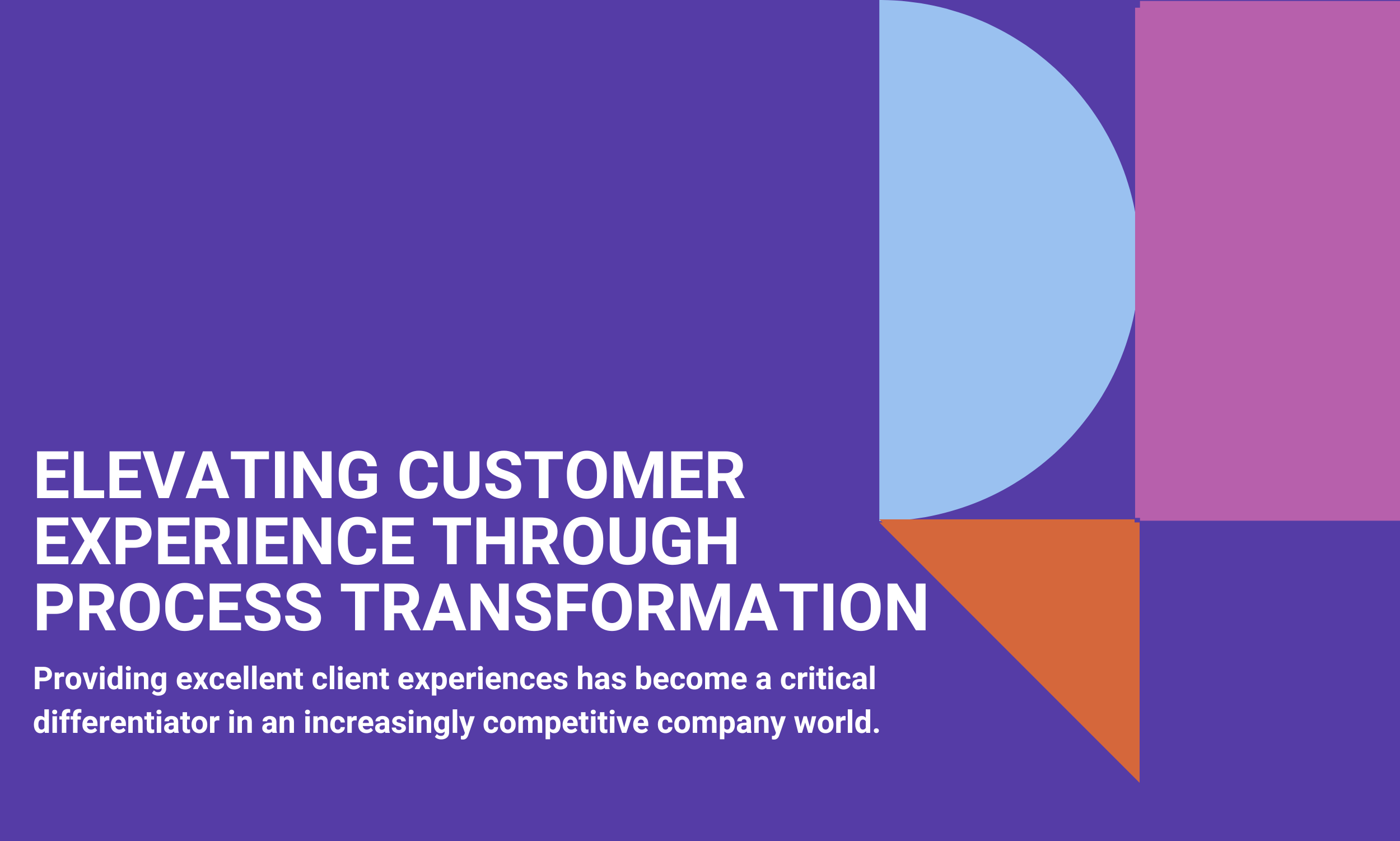Services List
Providing excellent client experiences has become a critical differentiator in an increasingly competitive company world. Organisations that thrive in this area outperform their competitors, leading to better levels of consumer satisfaction and loyalty. Process transformation can be an effective technique for achieving these higher experiences. In this post, we will look at how businesses may use process transformation to improve the customer journey, increase satisfaction, and drive long-term success.

Covered in this article
Identifying Pain Points in the Customer Journey
Harnessing Technology for Enhanced Customer Engagement
Empowering Employees to Deliver Exceptional Service
Aligning Processes with Customer Expectations
Measuring and Monitoring the Impact of Process Transformation
Quick Overview of Elevating Customer Experience Through Process Transformation
Elevating Customer Experience Through Process Transformation FAQs
Identifying Pain Points in the Customer Journey
The first step in elevating customer experience is to identify areas that require improvement. By analysing the customer journey, businesses can pinpoint their customers' pain points and inefficiencies, allowing them to make data-driven decisions on where to focus their process transformation efforts. Some common issues include:
- Lengthy response times
- Inaccurate or incomplete information
- Inconsistent communication
- Difficulty navigating the website or online portal
Addressing these problems through process transformation can lead to more streamlined and efficient customer interactions, ultimately improving the overall customer experience.
Harnessing Technology for Enhanced Customer Engagement
Technological advancements have made it possible to reimagine the way businesses engage with their customers. By integrating cutting-edge tools, such as artificial intelligence (AI), machine learning, and data analytics, businesses can automate repetitive tasks, personalise interactions, and gain valuable insights into customer behaviour.
For instance, chatbots can be used to provide instant support, resolve simple queries and direct customers to the appropriate channels for more complex issues. Meanwhile, data analytics can identify patterns and trends, enabling businesses to make informed decisions on how to enhance their customer experience strategy.
Empowering Employees to Deliver Exceptional Service
A key component of delivering outstanding customer experiences lies in empowering employees with the right tools, resources, and training. Process transformation can help streamline internal processes, reducing the time spent on administrative tasks and allowing employees to focus on higher-value activities.
By equipping employees with the necessary knowledge and skills, businesses can ensure that they are well-prepared to address customer needs and expectations. Additionally, fostering a culture of continuous improvement and innovation can inspire employees to seek out new ways to enhance customer experiences.
Aligning Processes with Customer Expectations
As customer expectations evolve, businesses must adapt their processes to meet these new demands. This may involve rethinking the way they interact with customers, making changes to their product or service offerings, or even redefining their overall business model.
For example, offering multiple communication channels, such as phone, email, live chat, and social media, can help cater to different customer preferences, ensuring that they can easily reach the business in their preferred method. Likewise, providing self-service options, such as knowledge bases and help centres, can empower customers to find answers to their questions independently, reducing the need for direct support.
Measuring and Monitoring the Impact of Process Transformation
Implementing process transformation initiatives is just the beginning. To truly elevate customer experience, businesses must continuously monitor and measure the impact of these changes. This can be achieved through a combination of quantitative metrics, such as customer satisfaction scores and Net Promoter Score (NPS), and qualitative feedback, gathered through customer surveys and reviews.
Regularly reviewing and analysing this data can help businesses identify areas where further improvements can be made, ensuring that they stay ahead of the curve in terms of customer experience excellence.
Quick Overview of Elevating Customer Experience Through Process Transformation
Elevating customer experience through process transformation involves identifying pain points in the customer journey, harnessing technology to enhance engagement, empowering employees, aligning processes with customer expectations, and measuring the impact of these changes. By embracing process transformation, businesses can not only improve customer satisfaction but also drive long-term success in today's competitive landscape.
At Velocity, our team of chartered accountants, internal auditors, and business process engineers can help you undertake this transformation. Through our Business Process Review, Design, and Automation service offering, we conduct a comprehensive audit of your current processes, identifying inherent risks and potential opportunities. We then design and optimise your ideal processes to maximise efficiency, mitigate risks, and capitalise on opportunities.
Leveraging HubSpot CRM technology, we automate and align your processes, enabling your business to reach its full potential while providing decision-makers with complete oversight through detailed dashboards of every process and function within your operation. Trust Velocity to help you elevate your customer experience and unlock the true potential of process transformation.
Elevating Customer Experience Through Process Transformation FAQs
What is customer experience transformation?
Customer experience transformation is the process of redefining and improving the way businesses interact with their customers, focusing on enhancing satisfaction and fostering loyalty. This transformation involves identifying pain points, streamlining processes, leveraging technology, empowering employees, and continuously measuring the impact of these changes to ensure the delivery of exceptional customer experiences.
How do you elevate the customer experience?
To elevate the customer experience, businesses should:
- Identify pain points in the customer journey
- Harness technology to enhance engagement
- Empower employees with the right tools and training
- Align processes with customer expectations
- Continuously measure and monitor the impact of implemented changes
By addressing these areas, businesses can create a more streamlined and satisfying customer journey, ultimately driving loyalty and long-term success.
How do I improve customer experience through digital transformation?
Improving customer experience through digital transformation involves:
- Integrating advanced technologies, such as AI, machine learning, and data analytics, to automate tasks and personalise interactions
- Offering multiple communication channels, including phone, email, live chat, and social media
- Providing self-service options, like knowledge bases and help centres, to empower customers
- Utilising data-driven insights to make informed decisions on customer experience strategy
- Continuously iterating and evolving processes based on customer feedback and expectations
By embracing digital transformation, businesses can enhance customer engagement and satisfaction, creating a competitive advantage in the market.
What are the five stages of the transformational customer experience?
The five stages of the transformational customer experience include:
- Awareness: Gaining a deep understanding of customer needs, expectations, and pain points, often through data analysis and customer feedback.
- Strategy Development: Creating a comprehensive plan to address identified issues and enhance the customer journey, incorporating technology, employee training, and process improvements.
- Implementation: Executing the devised strategy by implementing new technologies, tools, and processes while ensuring employees are well-equipped to deliver exceptional customer experiences.
- Measurement: Continuously monitoring and measuring the impact of the implemented changes through quantitative metrics and qualitative feedback, such as customer satisfaction scores, NPS, surveys, and reviews.
- Continuous Improvement: Utilising gathered data and insights to identify further areas for improvement, iterating on the existing strategy, and fostering a culture of innovation to maintain customer experience excellence.





